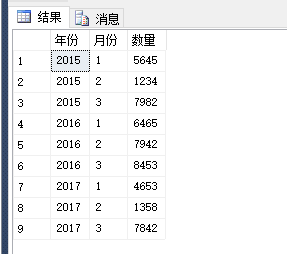这篇“SQL Server中怎么使用Pivot和UnPivot实现行列转换”文章的知识点大部分人都不太理解,所以小编给大家总结了以下内容,内容详细,步骤清晰,具有一定的借鉴价值,希望大家阅读完这篇文章能有所收获,下面我们一起来看看这篇“SQL Server中怎么使用Pivot和UnPivot实现行列转换”文章吧。
先创建一个用于演示的临时表:
create table #temp( 年份 nvarchar(10) null, 月份 nvarchar(10) null, 数量 int null)insert into #temp(年份,月份,数量)select '2015','1','5645' unionselect '2015','2','1234' unionselect '2015','3','7982' unionselect '2016','1','6465' union select '2016','2','7942' unionselect '2016','3','8453' unionselect '2017','1','4653' unionselect '2017','2','1358' unionselect '2017','3','7842' select * from #temp
下面来实现一些需求:
需求一,按年份分组,不同的月份为一列。
-- 按年份分组,不同的月份为一列select t.年份,sum(case t.月份 when '1' then t.数量 end) '1月份',sum(case t.月份 when '2' then t.数量 end) '2月份',sum(case t.月份 when '3' then t.数量 end) '3月份'from #temp tgroup by t.年份
另外两种方法:
-- 使用左外连接查询select t.年份,t1.数量 '1月份',t2.数量 '2月份',t3.数量 '3月份' from #temp tleft join (select 年份,数量 from #temp where 月份='1') t1 on t.年份=t1.年份left join (select 年份,数量 from #temp where 月份='2') t2 on t.年份=t2.年份left join (select 年份,数量 from #temp where 月份='3') t3 on t.年份=t3.年份group by t.年份,t1.数量,t2.数量,t3.数量-- 使用自连接查询select t.年份,t1.数量 '1月份',t2.数量 '2月份',t3.数量 '3月份' from #temp t,(select 年份,数量 from #temp where 月份='1') t1,(select 年份,数量 from #temp where 月份='2') t2,(select 年份,数量 from #temp where 月份='3') t3where t.年份=t1.年份 and t.年份=t2.年份 and t.年份=t3.年份group by t.年份,t1.数量,t2.数量,t3.数量
返回的结果都是一样的,可以看见这几种方法都是可以实现的(当然,可能还有更多的方法待发掘),不过比起第一种方法,后面这两种方法也太低效了吧,比如一年有12个月份的数据,有个七八年的,那得写多少个子查询、表连接的,而且第一种方法也不是我们想要的。那么就需要用到 Pivot 这种方法了。
Pivot 语法:
table_source -- 表名称,即数据源 PIVOT( 聚合函数(value_column) -- value_column 要转换为 列值 的列名 FOR pivot_column -- pivot_column 指定要转换的列 IN(<column_list>) -- column_list 自定义的目标列名)因为这里列名不允许指定为数字,真是无语。。。我重建了一个数据结构一模一样的表。
create table #temp( Name nvarchar(10) null, Course nvarchar(10) null, Score int null)insert into #temp(Name,Course,Score)select '小李','语文','88' unionselect '小李','数学','79' unionselect '小李','英语','85' unionselect '小明','语文','79' union select '小明','数学','89' unionselect '小明','英语','87' unionselect '小红','语文','84' unionselect '小红','数学','76' unionselect '小红','英语','92' select * from #tempgo
select Name 姓名,max(case Course when '语文' then Score end) 语文,max(case Course when '数学' then Score end) 数学,max(case Course when '英语' then Score end) 英语,sum(Score) 课程总分,cast(avg(Score) as decimal(18,2)) 课程平均分from #tempgroup by Name
使用 Pivot 进行 行转列:
select a.Name 姓名,a.语文,a.数学,a.英语from #temp pivot( max(Score) -- 指定作为转换的列的值 的列名 for Course -- 指定要转换的列的列名 in(语文,数学,英语) -- 自定义的目标列名,即要转换列的不同的值作为列)
select a.Name 姓名,a.语文,a.数学,a.英语,b.SumScore 课程总分,b.AvgScore 课程平均分from #temp pivot( max(Score) -- 指定作为转换的列的值 的列名 for Course -- 指定要转换的列的列名 in(语文,数学,英语) -- 自定义的目标列名,即要转换列的不同的值作为列)a,( select t.Name,sum(t.Score) SumScore,cast(avg(t.Score) as decimal(18,2)) AvgScore from #temp t group by t.Name)bwhere a.Name=b.Name
UnPivot 语法:
table_source -- 表名称,即数据源 UNPIVOT( value_column -- value_column 要转换为 行值 的列名 FOR pivot_column -- pivot_column 指定要转换为指定的列 IN(<column_list>) -- column_list 目标列名)create table #temp( Name nvarchar(10) null, Chinese int null, Math int null, English int null)insert into #temp(Name,Chinese,Math,English)select '小李','88','79','85' unionselect '小明','79','89','87' unionselect '小红','84','76','92' select * from #tempgo
select t.Name 姓名,t.Course 课程,t.Score 分数 from(select t.Name,Course='Chinese',Score=Chinese from #temp tunion allselect t.Name,Course='Math',Score=Math from #temp tunion allselect t.Name,Course='English',Score=English from #temp t) torder by t.Name,t.Courseselect t.Name 姓名,t.Course 课程,t.Score 分数 from(select t.Name,'Chinese' Course,Chinese Score from #temp tunion allselect t.Name,'Math',Math from #temp tunion allselect t.Name,'English',English from #temp t) torder by t.Name,t.Course
使用 UnPivot 进行 列转行:
select t.Name 姓名,t.Course 课程,t.Score 分数 from #temp unpivot ( Score for Course in(Chinese,Math,English))
以上就是关于“SQL Server中怎么使用Pivot和UnPivot实现行列转换”这篇文章的内容,相信大家都有了一定的了解,希望小编分享的内容对大家有帮助,若想了解更多相关的知识内容,请关注编程网行业资讯频道。






